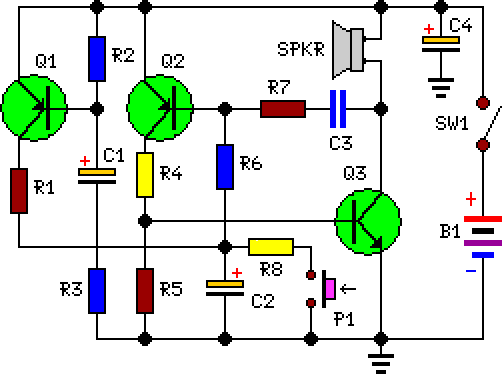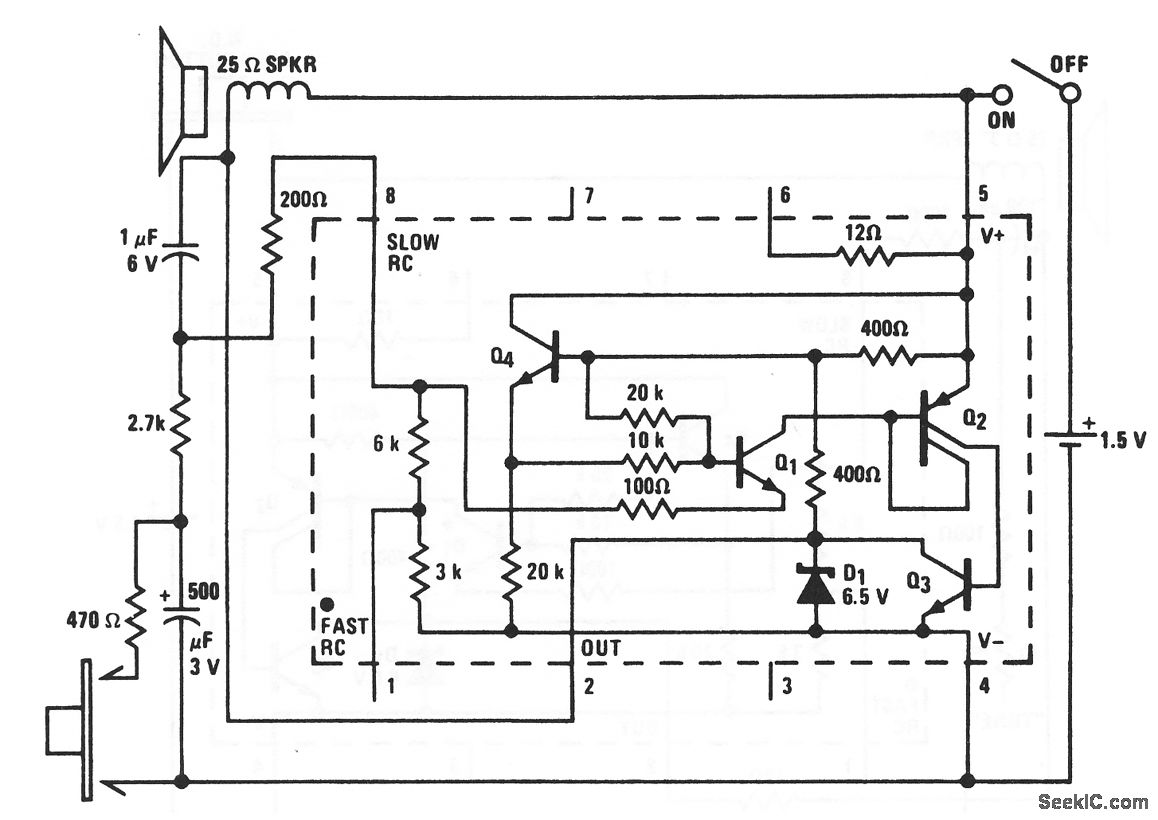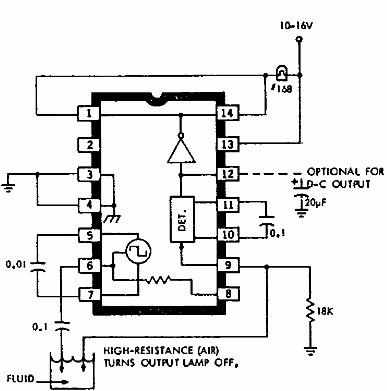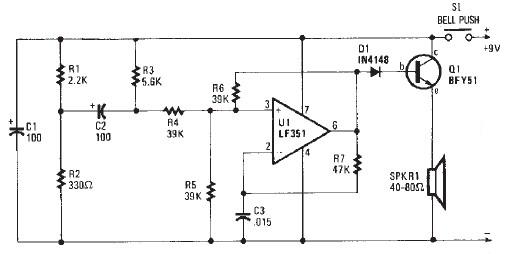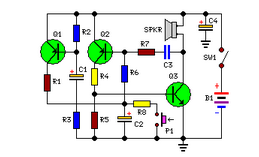
Electronic Siren with Multitone
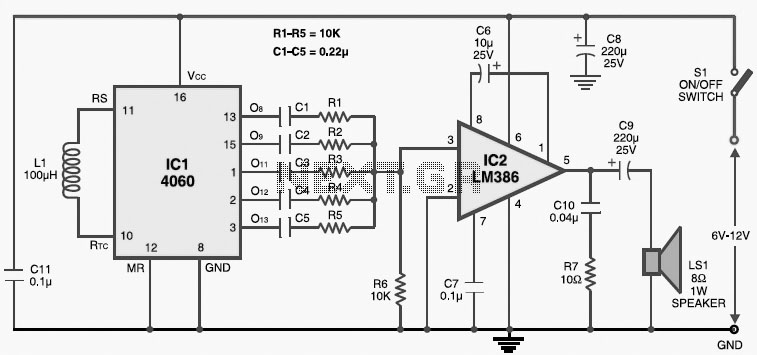
This multitone electronic siren is useful for burglar alarms, reverse horns, etc. It produces five different audio tones and is much more attention-grabbing than a single-tone siren. The circuit is built around the popular CMOS oscillator-divider IC 4060 and a small audio amplifier LM386. IC 4060 serves as the multitone generator. A 100 µH inductor is used at the input of IC 4060, allowing it to oscillate within the range of approximately 5 MHz RF. IC 4060 divides RF signals into audio frequency (AF) and ultrasonic ranges. Audio signals of different frequencies are available at pins 1, 2, 3, 13, and 15 of IC 4060 (IC1). These multifrequency signals are mixed and fed to the audio amplifier built around IC LM386. The output of IC2 is sent to the speaker through capacitor C9. For a louder sound, a power amplifier such as TBA810 or TDA1010 can be used. Only five outputs of IC1 are utilized, as the other five outputs (pins 4 through 7 and 14) produce ultrasonic signals, which are inaudible.
The multitone electronic siren circuit is designed to enhance alertness in various applications such as security systems and vehicle reverse alarms. The core component, the CMOS oscillator-divider IC 4060, operates by generating a high-frequency signal that is subsequently divided into lower frequency audio tones. The 100 µH inductor connected to the input of IC 4060 plays a crucial role in determining the oscillation frequency, allowing the circuit to maintain a stable output within the RF range.
The audio frequencies generated at pins 1, 2, 3, 13, and 15 of IC 4060 provide a range of distinct tones. These signals are mixed together before being amplified by the LM386 audio amplifier. The LM386 is a low voltage audio power amplifier capable of delivering sufficient output to drive a small speaker, making it ideal for this application. The output from the LM386 is coupled to the speaker through capacitor C9, which blocks any DC component and allows only the AC audio signal to pass through.
For applications requiring increased sound output, the circuit can be upgraded by incorporating a power amplifier such as the TBA810 or TDA1010. These amplifiers are capable of delivering higher power levels, thus significantly enhancing the volume of the siren.
It is important to note that while the IC 4060 offers ten output pins, only five are utilized for generating audible tones, as the remaining outputs produce ultrasonic frequencies that are not perceivable by human ears. This design choice ensures that the circuit remains efficient while effectively delivering multiple distinct audio signals to alert users in a variety of scenarios.This multitone electronic siren is useful for burglar alarms, reverse horns, etc. It produces five different audio tones and is much more earcatching than a single-tone siren. The circuit is built around popular CMOS oscillator-cum-divider IC 4060 and small audio amplifier LM386. IC 4060 is used as the multitone generator. A 100 H inductor is use d at the input of IC 4060. So it oscillates within the range of about 5MHz RF. IC 4060 itself divides RF signals into AF and ultrasonic ranges. Audio signals of different frequencies are available at pins 1, 2, 3, 13 and 15 of IC 4060 (IC1). These multifrequency signals are mixed and fed to the audio amplifier built around IC LM386. The output of IC2 is fed to the speaker through capacitor C9. If you want louder sound, use power amplifier TBA810 or TDA1010. Only five outputs of IC1 are used here as the other five outputs (pins 4 through 7 and 14) produce ultrasonic signals, which are not audible. 🔗 External reference
The multitone electronic siren circuit is designed to enhance alertness in various applications such as security systems and vehicle reverse alarms. The core component, the CMOS oscillator-divider IC 4060, operates by generating a high-frequency signal that is subsequently divided into lower frequency audio tones. The 100 µH inductor connected to the input of IC 4060 plays a crucial role in determining the oscillation frequency, allowing the circuit to maintain a stable output within the RF range.
The audio frequencies generated at pins 1, 2, 3, 13, and 15 of IC 4060 provide a range of distinct tones. These signals are mixed together before being amplified by the LM386 audio amplifier. The LM386 is a low voltage audio power amplifier capable of delivering sufficient output to drive a small speaker, making it ideal for this application. The output from the LM386 is coupled to the speaker through capacitor C9, which blocks any DC component and allows only the AC audio signal to pass through.
For applications requiring increased sound output, the circuit can be upgraded by incorporating a power amplifier such as the TBA810 or TDA1010. These amplifiers are capable of delivering higher power levels, thus significantly enhancing the volume of the siren.
It is important to note that while the IC 4060 offers ten output pins, only five are utilized for generating audible tones, as the remaining outputs produce ultrasonic frequencies that are not perceivable by human ears. This design choice ensures that the circuit remains efficient while effectively delivering multiple distinct audio signals to alert users in a variety of scenarios.This multitone electronic siren is useful for burglar alarms, reverse horns, etc. It produces five different audio tones and is much more earcatching than a single-tone siren. The circuit is built around popular CMOS oscillator-cum-divider IC 4060 and small audio amplifier LM386. IC 4060 is used as the multitone generator. A 100 H inductor is use d at the input of IC 4060. So it oscillates within the range of about 5MHz RF. IC 4060 itself divides RF signals into AF and ultrasonic ranges. Audio signals of different frequencies are available at pins 1, 2, 3, 13 and 15 of IC 4060 (IC1). These multifrequency signals are mixed and fed to the audio amplifier built around IC LM386. The output of IC2 is fed to the speaker through capacitor C9. If you want louder sound, use power amplifier TBA810 or TDA1010. Only five outputs of IC1 are used here as the other five outputs (pins 4 through 7 and 14) produce ultrasonic signals, which are not audible. 🔗 External reference
